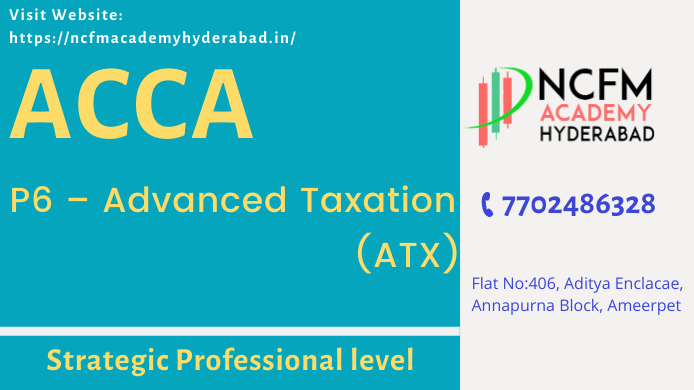Advanced Taxation (ATX) is the thirteenth exam of your ACCA journey. Advanced Taxation is also an optional exam. There are four optional exams in the ACCA professional level, Advanced Financial Management, Advanced Performance Management, Advanced Taxation, Advanced Audit and Assurance, students will be required to choose any two optional subjects. NCFM Academy Hyderabad is Leading Training institute for Financial Course running ACCA Paper P6 Advanced Taxation course in its Ameerpet branch.
Advanced Taxation (ATX) builds upon your earlier studies including Taxation (TX) and aims to give the students a broader understanding of concepts related to different areas of taxation, thus allowing the students to tackle challenges and different scenarios with professional conduct.
Exam Format
The syllabus is assessed by a three hour fifteen minutes examination.
The exam consists of two sections:
Section A consists of two compulsory case-study questions. Question 1 has 35 marks, including four professional marks and question 2 has 25 marks. There will also be five ethics marks included in this section.
Section B consists of two compulsory 20-mark questions, covering both business and personal tax issues. Candidates will be expected to undertake both calculation and narrative work. The questions will be scenario-based and may involve consideration of more than one tax, some elements of planning and the interaction of taxes.
Tax rates, allowances, and information on certain reliefs will be given in the exam
Syllabus of ACCA Paper P6 Advanced Taxation
The syllabus is divided into five sections with further subsections
A- Knowledge and understanding of the UK tax system through the study of more advanced topics within the taxes studied previously and the study of stamp taxes.
This is the first section of this syllabus and it covers the advanced understanding of the UK tax system. Students will learn about income and income tax liabilities in situations involving further overseas aspects and in relation to trusts and the application of additional exemptions and reliefs.
The areas of income tax which will be covered include income from employment, self-employment and investment income with a comprehensive calculation of taxable income and tax liability.
This section also covers chargeable gains and capital gains tax liabilities in situations involving further overseas aspects and in relation to closely related persons and trusts and the application of additional exemptions and reliefs.
The areas of capital gains which will be covered include the scope of capital gains, capital gains tax and trusts, the basics of computing capital gains and losses, the disposal of movable and immovable poverty, the disposal of shares and securities and the use of exemptions and relief in deferring and minimizing tax liabilities.
This section also covers inheritance tax in situations involving further aspects of the scope of the tax and the calculation of the liabilities arising, the principles of valuation and the reliefs available, transfers of property to and from trusts, overseas aspects and further aspects of administration.

The areas of inheritance covered include basic principles of computing transfers of value, liabilities arising on chargeable lifetime transfers and on death of individuals, liabilities arising in respect of transfers to and from trusts and on property within trusts, use of exemptions and reliefs in deferring and minimizing inheritance tax liabilities and the system by which inheritance tax is administered including the option to pay in installments.
This section also covers corporation tax liabilities in situations involving overseas and further group aspects and in relation to special types of company and the application of additional exemptions and reliefs.
The areas of corporation covered include a basic scope of corporation tax, taxable total profits, chargeable gains, comprehensive computation of corporate tax liability, group taxation and the use of exemptions and reliefs in deferring and minimizing corporation tax liability.
This section also covers stamp taxes and value-added tax, tax administration and the UK tax system
B- The impact of relevant taxes on various situations and courses of action, including the interaction of taxes.
This is the second section of this course and it requires the students to identify and advise on the taxes applicable to a given course of action and their impact, identify and understand that the alternative ways of achieving personal or business outcomes may lead to different tax consequences, Advise how taxation can affect the financial decisions made by businesses (corporate and unincorporated) and by individuals, assess the tax benefits and drawbacks of alternate course of action and understand the statutory implications.
C- Minimising and/or deferring tax liabilities by the use of standard tax planning measures
This is the third section of this course it requires the students to identify and advise on the types of investment and other expenditure that will result in a reduction in tax liabilities for an individual and/or a business, advise on legitimate tax planning measures, by which the tax liabilities arising from a particular situation or course of action can be mitigated, advise on the appropriateness of such investment, expenditure or measures given a particular taxpayer’s circumstances or stated objectives, advise on the mitigation of tax in the manner recommended by reference to numerical analysis and/or reasoned argument and be aware of ethical and current issues relating to tax.
D- Communicating with clients, HM Revenue and Customs and other professionals
This is the fourth section of this course and it requires the students to be effective in communication of advice, recommendations, and information in the required format, presentation of written information, in language appropriate to the purpose of the communication and the intended recipient.
Students will need to communicate the conclusions reached with relevant computations and details, stated the assumptions and limitations inherent in their analysis and other non-tax factors that need to be covered.
